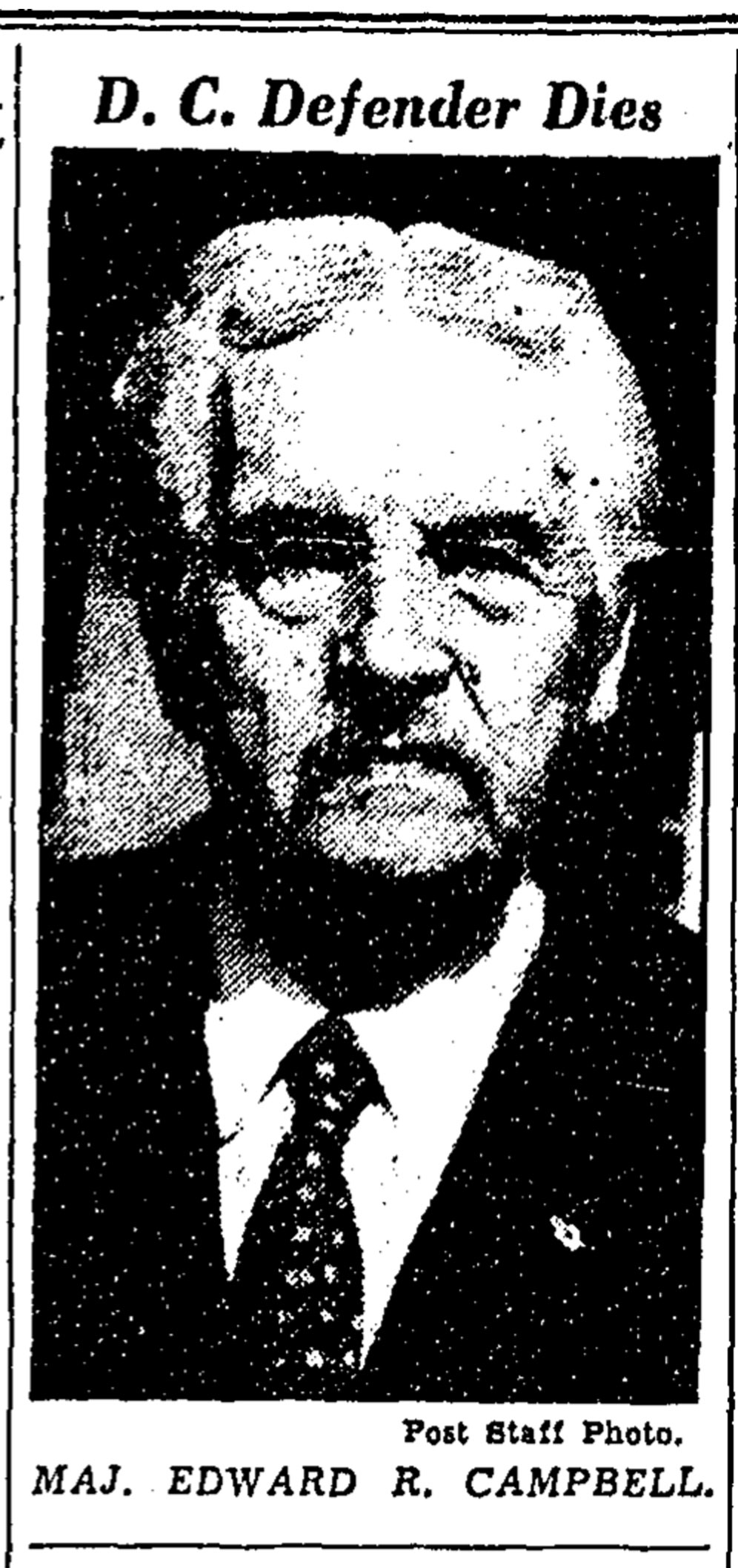The Washington Post, Mar 11, 1936, Pg. 10
Campbell, Last of City's 1865 Defenders, Dies
Veteran of Stand Against Genl. Early Succumbs to Pneumonia.
Maj. Edward R. Campbell, the last known survivor of the Union Army that turned Confederate invaders away from Washington, died last night of pneumonia in Mount Alto Hospital.
He was 92 years old and until the brief illness that caused his death, had been in excellent health.
As recently as last July, Maj. Campbell took part in ceremonies observing the seventy-first anniversary of the Battle of Fort Stevens conducted on the grass-covered remnants of the fort in Brightwood.
Maj. Campbell was a member of the Sixth Army Corps that was rushed up from City Point to the Capital to meet 18,000 Confederate soldiers under Gen. Jubal Early, fresh from a victory at Monocacy and destined, it seemed to its terrified residents, to capture the Union Capital.
Memory Clear.
Maj. Campbell's recollections of those stirring days were unusually clear for one of his age. Here is how he once recounted details of the Capital's saving for a reporter:
“We arrived in Washington on the morning at the twelfth (August 12, 1864). President Lincoln was there to meet us. He shook our hands. The population was certainly glad to see us.
“When we reached the place where New Hampshire avenue now crosses Oregon avenue, we heard the firing of musketry and were ordered to the fighting double quick.”
Maj. Campbell was among those deployed as skirmishers near the fort. But he saw Lincoln mount the ramparts in the enemy fire and heard Gen. H. G. Wright, Commander of the fort, order the commander-in-chief of Army to come down and take a position less vulnerable.

MAJ. EDWARD R. CAMPBELL
Was Unwounded.
Maj. Campbell fought throughout the war's four years without being wounded. He saw action at Gettysburg and in dozens of other campaigns and battles. He enlisted from Vermont, where he was born at Londonderry in 1844, with Company G of the First Vermont Volunteers.
Relatives of Maj. Campbell last night were making arrangements for him to join his comrades; the 40 Union soldiers who died in defense or the fort and who were buried where they fell. The spot has since become known as the Battleground National Cemetery and it is here that Major Campbell will be buried.
It was over this same hallowed ground that Maj. Campbell walked in the unsteadiness of advanced age last July and where he walked many times before when citizens of the Capital found occasion to venerate the place and its dead. A boulder bearing a bronze plaque occupies a place on the rampart marking the spot where Maj. Campbell saw the war President standing.
Campbell lived with members of his family at 30 Elm avenue in Takoma Park, Md. He fell sick there on Washington's Birthday.
Surviving are his daughter, Mrs. A. B. Goorich, a granddaughter, Mrs. Marion G. Nevitt, and two great grandchildren, Robert and Jack Nevitt. All live at the Takoma Park address.
Retired in 1915.
Following the war. Maj. Campbell returned to Vermont and entered business. After a few years he returned to the Capital and took a position with the pension Office, retiring in 1915 after a service 43 years.
It was while employed at the Pension Office that Maj. Campbell met for the first time since the successful defense of the fort the boy who so won the soldier's admiration that he shared with him his blankets and rations.
The boy, later identified as Ed Byrne, was driven from his home in Silver Spring by the Confederates. The enforced evacuation so enraged him that he salvaged a rifle, crossed into the Union lines and sniped at the Grey from behind trees.
Campbell and Byrne met next as employes in the pension Office in 1882.
Maj. Campbell came by his title as major of the Fourth Battalion of the District National Guard. As a Union soldier he served as private.
He was past commander in chief of the Sons of Veterans, a member of the G. A. R., a thirty-second degree Mason and a Shriner.
Campbell, Last of City's 1865 Defenders, Dies, The Washington Post, Mar 11, 1936, Pg. 10. (PDF)